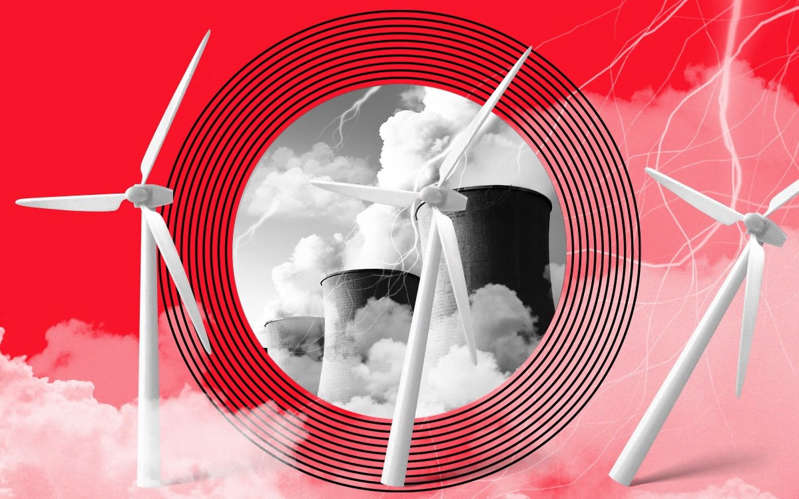Wind farms deliver almost a fifth of Britain’s electricity, but a freak anticyclone has hovered over Western Europe since mid-August, bringing calmer weather and low wind speeds, sapping power production.
According to energy consultant Cornwall Insight, wind typically accounts for 18pc of the nation’s power mix, a share which has dropped to just 2pc in the past month.
“All other things being equal, a mild start to the winter with some windy weather would be peachy,” according to its lead analyst Tim Dixon.
“Right now, eyes are going to be turning to medium-term weather forecasts for autumn and the start of winter. That will have a big role to play in gas demand.”
But not all of the country’s energy difficulties will be gusted away even if the winds begin to blow again.
Industry critics argue that the drive for greener energy has driven up costs, while previous decisions have exacerbated the dependence on imports and left Britain more vulnerable to geopolitical power plays as Russia’s Vladimir Putin starves Europe of gas.
How did we get here?
Pundits often reach for the hackneyed phrase of a “perfect storm” to describe a crisis, but when renewable energy accounts for 40pc of electricity generation – up from around 10pc a decade ago – Britain’s headaches are partly caused by an uncanny calm.
The unfavourable weather conditions have forced Britain to turn to gas to fill the gap, but it comes at a time when demand for gas worldwide has never been higher. Faster growing Asian economies reawakening after the pandemic and filling storage sites after a harsh winter in 2020 are sucking up liquified natural gas, reducing the supplies reaching Europe.
Freak weather is also playing its part elsewhere as droughts in Brazil and Argentina dent electricity output from their hydroelectric plants, forcing both to take up the slack in the gas market. At 164p a therm, gas prices are already around triple the average of the last decade.
Other factors behind the spike in prices include the maintenance season for Britain’s nuclear fleet as it readies for rising winter demand. “There’s been about four or five nuclear reactors offline in the GB market of the 14 or 15 that are available,” Dixon says. Last week’s blaze in Kent will meanwhile close the main subsea electricity cable with France until March, again pushing up gas prices.
As North Sea supplies dwindle, the UK imports almost half of its gas, mostly from Norway, with some from the continent.
But the Kremlin is putting its foot on the throat of the European market in its bid to gain approval for the Nordstream 2 pipeline from Germany. State-owned Gazprom is supplying the bare contractual minimum to Europe, leaving storage sites just 70pc full weeks before the start of the heating season.
Is the crisis temporary?
Despite the prominent short-term drivers of the current spike, experts say policy decisions have also increased the UK’s energy vulnerability. In 2019, the Government U-turned on fracking – once described by Boris Johnson as “glorious news for humanity” – following a long campaign by environmentalists amid concerns over earth tremors near fracking sites.
British Gas owner Centrica also closed the vast Rough offshore gas storage facility in 2017 on the grounds that it was uneconomic to run. But that decision cut the country’s strategic gas storage to less than 2pc of annual demand, leaving Britain more exposed to the vagaries of volatile wholesale markets.
Andrew Large, chairman of the Energy Intensive Users Group, said the Noughties’ “dash for gas” has left the country with few options beyond expensive gas.
“We’ve talked for a long time about potential grid instability due to reliance on intermittent renewables. We’ve been in a situation where our major sources of electricity are gas and wind. And when the wind doesn’t blow, as it hasn’t been for the last few weeks, then gas has to take up the slack.”
Large adds that UK industry pays higher prices than Europe for its energy due to “political decisions about who pays the bills for the decarbonisation process”. Regulator Ofgem said in July that a raft of policy measures such as the Renewables Obligation and the Carbon Price Support meant that “Britain’s prices were consistently above the EU median and the most expensive overall”.
How do we fix it?
In the short-term, experts hope that big producers such as the US and Australia will respond to market signals by pumping more gas. “The question is whether the increase in production capacity can catch up with rising global demand levels,” Dixon says.
But he adds that Britain faces a “transition period” in the power market as coal-fired plants are closed on green grounds and its nuclear fleet ages.
That means more investment in nuclear energy and greater diversification, according to Large. “To my mind, if decarbonisation is the priority that the Government says it is, then we should be aiming for French levels of nuclear power investment.”
He adds that “some of those decisions around UK energy security and sourcing are starting to come home to roost” and that politicians need to adapt to a more uncertain world.
He says: “We have to go back to focusing on the fundamentals. And the fundamentals in this particular case, are ensuring that we have enough electrons under all conceivable sets of circumstances in order to be able to keep the lights on at reasonable prices. That therefore means gas storage, it means diversification of supply, it means greater autarky.
“I’m not suggesting self sufficiency or closing international markets. But it means having greater control over your ability in matters like energy security.”
In the longer term, KPMG’s energy chief Simon Virley says the Government should “double down” on green energy as it moves towards net zero by 2050: “This will help to reduce our growing dependency on imported fossil fuels, boost energy security and meet our carbon reduction goals.”
What does it mean for the economy?
The Bank of England is already in a tight spot as inflation hit 3.2pc in August, well above its 2pc target.
That will jump further when the energy price cap rises more than 12pc in October, ramping up pressure on the Bank to rein in its ultra-loose policy of £3.4bn of quantitative easing every week and interest rates at the historic low of 0.1pc.
George Buckley, economist at Nomura, predicts the Consumer Prices Index will hit 4.4pc in the final quarter of this year. But he expects inflation to fade relatively quickly through 2022, which means the Bank may ignore the burst of price hikes unless it feeds into demands for higher wages.
“The Bank will be watching core inflation, inflation expectations and wages – all of those are absolutely crucial,” says Buckley, adding that so far there are few signs of a “wage-price spiral”.
A further double-digit rise in the price cap looks likely next April although it is not clear what levers the Bank of England can pull to rein in energy prices driven by external factors such as global demand and low winds.
Because higher bills drain funds from households, the economy could take a hit, says Andrew Goodwin at Oxford Economics, potentially prompting the Bank to keep rates lower for longer to boost family finances and support the recovery.
“These sorts of increases in prices, which are completely divorced from the domestic economy, are likely to weigh on demand and on underlying inflationary pressures, so I would be surprised if the Bank used this as an extra reason to tighten policy – it is more an issue for the strength of the recovery and an added concern,” he says.
Original Article – https://www.msn.com/en-gb/money/other/inside-britains-energy-crisis-and-how-to-fix-it/ar-AAODOkU



